#Gastornis
Explore tagged Tumblr posts
Text

POV: your most liked FB Post is a meme about Gastornis
4K notes
·
View notes
Text














Paleogene critters!
65 to 23 million years ago, when the mammals took over the globe!
Andrewsarchus - Indohyus - Entelodont / Hell Pig
Ambulocetus - Hyracodon - Basilosaurus
Hyaenodon - Uintatherium - Gastornis
Moeritherium - Titanoboa - Eohippus
Proailurus - Megacerops
Stickers || Phone Wallpapers Masterlist
Planned or in the works: Dinictis, Arsinoitherium, Vasuki indicus, Perucetus, Dorudon, Palaeolagus, Gomphos, Barinasuchus
#art#my art#paleoart#paleontology#science#illustration#dinosaur#proailurus#megacerops#moeritherium#titanoboa#eohippus#gastornis#uintatherium#hyaenodon#basilosaurus#hyracodon#ambulocetus#indohyus#entelodont#hell pig#andrewsarchus
179 notes
·
View notes
Text

67 notes
·
View notes
Text
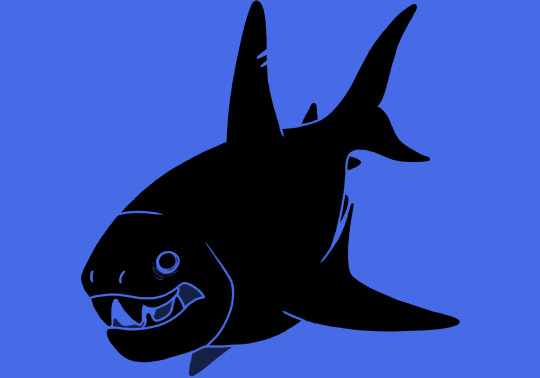

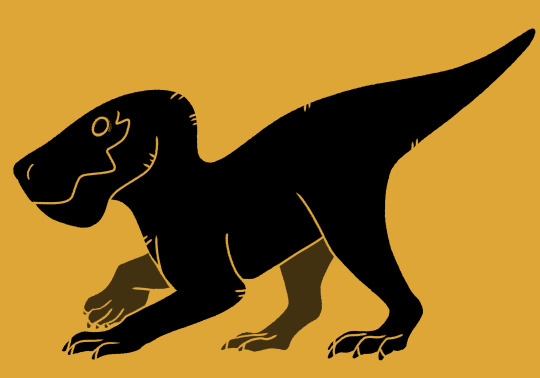
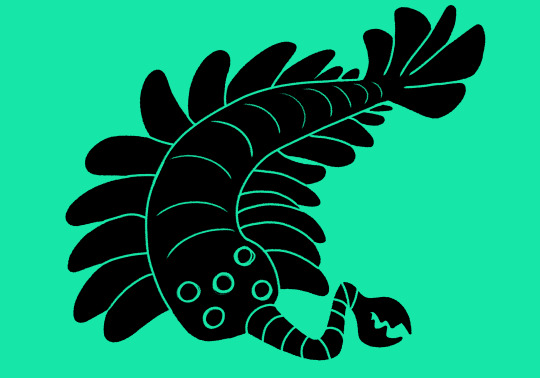
PALEOART BE UPON YE
shown here are dunkleosteus, gastornis, inostrancevia and opabinia!
#dunkleosteus#chunkleosteus#paleoart#paleontology#gastornis#opabinia#inostrancevia#gorgonopsid#gorgonops#dinosaur#bird#terror duck#natural history#fish#placoderm#silhouettes#animal art#creature art#extinct animals#extinct#sombertide art
1K notes
·
View notes
Text

Diatryma (Gastornis) chasing a small miacid through the mid-eocene brush
#I made painted this while listening to dinosaur (akmu) and everything from The Dinosaur’s skin#if you don’t know all their songs are prehistoric themed and so funky I love it when a band has a great gimmick#my art#artists on tumblr#digital art#digital painting#illustration#paleoart#paleoblr#gastornis#miacis#diatryma#does anyone still say that#paleogene#eocene
52 notes
·
View notes
Text
Fossil Novembirb: Day 4 - Megafowl
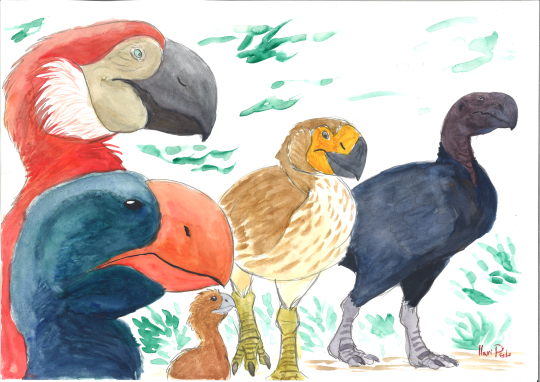
Gastornis, affectionally known as the Megafowl, was one of the largest, and certainly one of the most famous, birds of the Early Cenozoic. It stood two metres tall, and had a diet of mostly fruit, seeds and nuts. And that impressibe beak certainly help it crack nuts. These giants lived all over the Northern Hemisphere, as their bones have been found in North America, Europe and Asia. Even close to the North Pole! And contrary to popular belief, Gastornis did not die out as mammals grew to larger sizes. They lived with all sorts of large carnivorous and herbivorous mammals from the Paleocene to the Eocene, and got along with them just fine. And while it did not eat early horses, they might have been wise to stay clear of these mega fowl.
All this put together, it's no wonder Gastornis (also known for its former name Diatryma), a giant flightless herbivorous relative of ducks, got its own day.
#Fossil Novembirb#Novembirb#Dinovember#birblr#palaeoblr#Birds#Dinosaurs#Cenozoic Birds#Gastornis#Megafowl
89 notes
·
View notes
Text

Dino figure of the day: Safari LTD Gastornis
20 notes
·
View notes
Text
Gastornis

In my head I saw chickens jumping to reach redcurrants and just went with it.
#fossil novembirb#palaeoblr#birdblr#gastornis#I have a cold#no energy for anything but squiggling on my phone#maybe I’ll take time to gather the sources some day
106 notes
·
View notes
Text

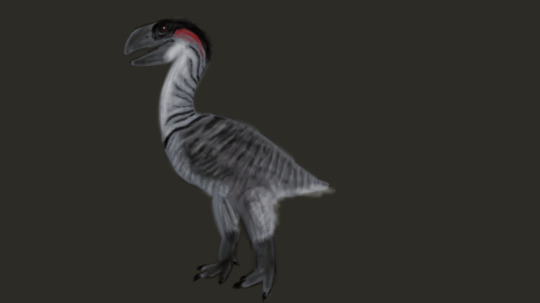
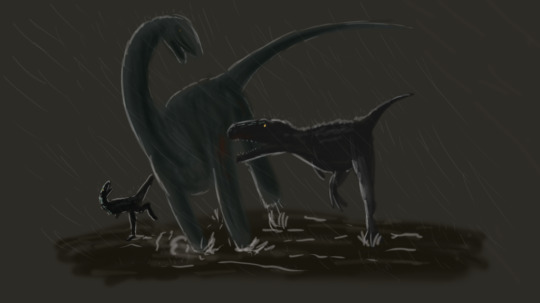
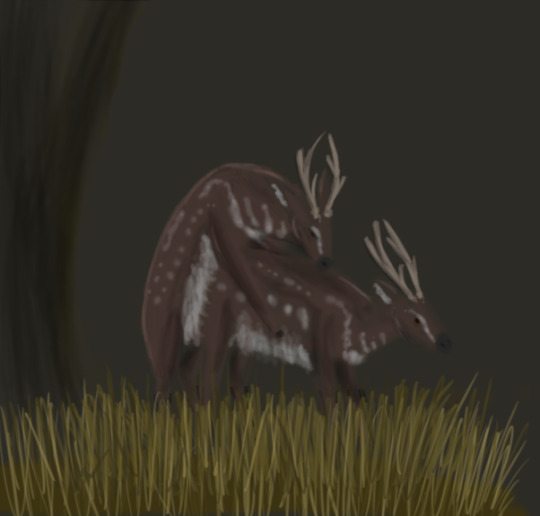
Saltriovenator at sunset picking up a washed up Cenoceras Gastornis Spectrovenator hunting a Tapuiasaurus in the rain moments before disaster. A pair of Pavlodaria orlovi bucks have some "quality time".
#paleoart#paleontology#paleostream#20 minute sketch#dinosaurs#deer#Saltriovenator#Cenoceras#gastornis#Spectrovenator#Tapuiasaurus#Pavlodaria#gay animals
78 notes
·
View notes
Text
FOSSIL NOVEMBIRB - DAY 4
I like not having to choose what to draw for the day tbh, way less work for me.
Anyways! A Gastornis!

As always, you can get all these cute stuff in my redbubble

50 notes
·
View notes
Text
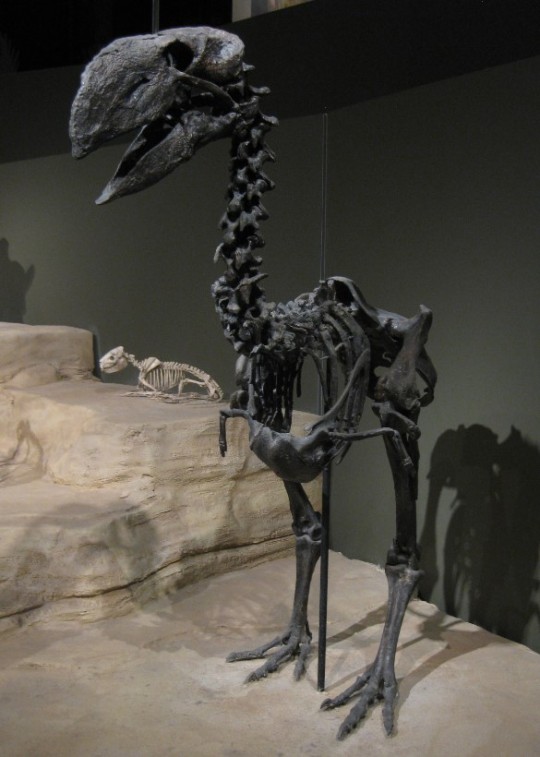
August's Fossil of the Month - Gastornis (Gastornis spp.)
Family: Gastornis Family (Gastornithidae)
Time Period: Early Paleogene (55-40 Million Years Ago)
Roughly 66 million years ago, the Cretaceous period ended in a sudden mass extinction event known as the Cretaceous-Paleogene Extinction Event in which as many as 75% of all terrestrial animal and plant species went extinct, with the vast majority of large animals (specifically most species weighing more than 25kg/55lbs, including all non-avian dinosaurs) being among the most notable losses. Following this massive plummet in biodiversity the relatively small number of species that survived into the earth's next geological period, the Paleogene, were left to "inherit the earth", and as environmental conditions stabilised and the surviving plant species began to diversify and become more prominent, an increase in the availability of food allowed the descendants of the extinction event's survivors to gradually grow to larger sizes. The members of the genus Gastornis are examples of animals that took advantage of this new opportunity; thought to be descended from small duck or pheasant-like animals, Gastornis species were enormous flightless birds (with the largest species, Gastornis gigantea, growing to be up to 2 meters/6.5 feet tall) with long legs and muscular necks supporting huge, powerful beaks, the purpose of which has been the subject of extensive debate - historically it was suggested that the presumably powerful legs and bill of Gastornis species were adaptations that aided them in pursuing, catching and killing the many smaller herbivorous mammals with which they coexisted, but following the discovery of more complete fossils (which show that species in this genus lacked the powerful claws and sharp-tipped beak seen in most modern carnivorous birds, and which contained trace minerals more common in the bones of herbivores than those of carnivores,) it is now generally believed that Gastornis species were likely herbivorous, with their huge beaks allowing them to break open hard-shelled fruits and seeds in a manner comparable to that seen in modern macaws and cockatoos. Gastornis fossils have been found across Asia, Europe and North America (having presumably used land bridges to spread between continents,) all of which would have been warmer and more humid than today at the time, allowing for the growth of dense rainforests that would have provided abundant food for a large browsing herbivore; as the Paleogene period progressed the climate became progressively warmer and drier and rainforests became rarer, likely contributing to the eventual extinction of Gastornis species. The name Gastornis translates roughly to "Gaston's Bird", honouring the French physicist Gaston Planté who is credited with having discovered the first known Gastornis fossils in a mine in Meudon, France in 1855.
--------------------------------------------------------------------------Image Source: tps://commons.wikimedia.org/wiki/File:Gastornis,_a_large_flightless_bird_from_the_Eocene_of_Wyoming.jpg
#gastornis#zoology#biology#ornithology#paleontology#wildlife#prehistoric wildlife#animal#animals#bird#birds#prehistoric animals#Asian wildlife#North American wildlife#European wildlife
69 notes
·
View notes
Text
Fossil Novembirb 4: The Megafowl

By @thewoodparable
One of the *most* iconic dinosaurs of the Cenozoic has got to be Gastornis, often referred to as "Diatryma", the giant fowl of the Early Paleogene. This animal first appeared between 60 and 56 million years ago in Europe, and spread to Asia and North America during the earliest Eocene. In the hot temperatures of the Paleocene-Eocene Thermal Maximum, it even lived up in the Arctic Circle, in the Tropical Polar Forests of the period. This single genus lasted a while, living until the middle Eocene, around 45 million years ago.
Gastornis is most famous due to its size, growing as tall as 2 meters height and up to 175 kilograms in mass. This made it one of the largest birds known, with a giant head and extremely tall beak. The skull itself was very powerfully built, with the beak compressed and lacking the raptorial hook of the later appearing terror birds.
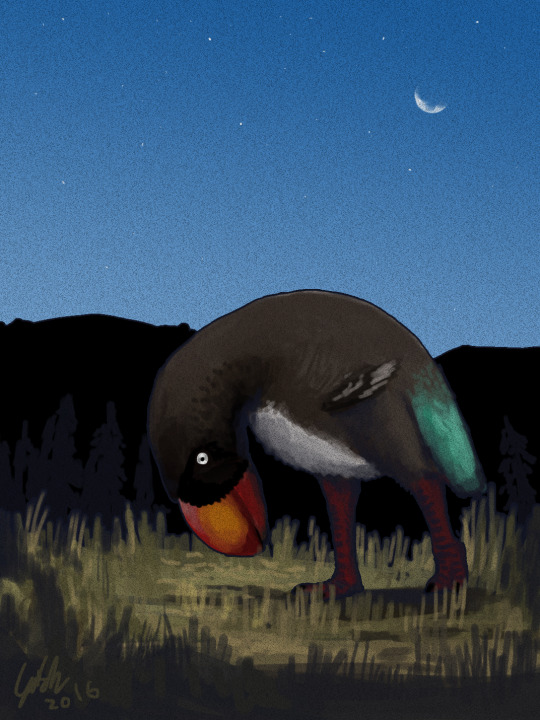
By Ashley Patch
This is important to note, because for a long time - until 2014, really - we thought Gastornis was a predator. Turns out, however, it was an herbivore, probably feeding on a generalistic diet of plants similar to other macroherbivorous dinosaurs. In fact, not only did it not have a predatory beak, but footprints that are probably from Gastornis suggest it did not have talons or raptorial feet adapted for hunting, either.
Feathers of Gastornis are not definitively known, however, a feather impression from the Green River Formation may be that of Gastornis due to its large size, and resembled feathers found on flighted birds, rather than the shaggy feathers of ratites. This is notable, as it seems that Gastornis was closely related to the "Fowl", aka Galloanserae, rather than the modern flightless ratites of today. Whether it's closer to ducks or to chickens is a question, hence the generic moniker of "Megafowl".
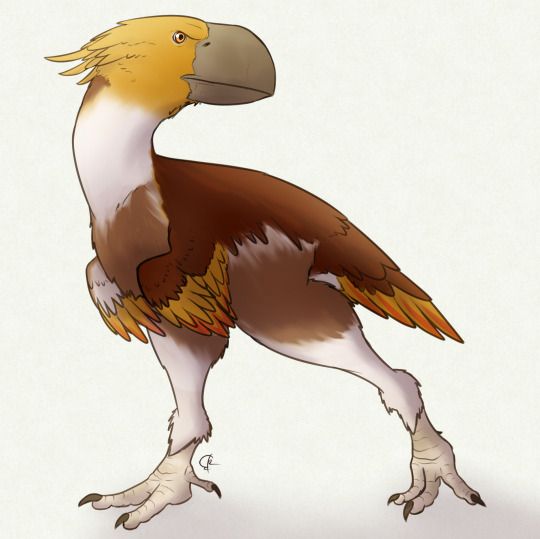
By @quetzalpali-art
Why did Gastornis go extinct? The answer is unclear. It seemed to have disappeared from North America and Asia at the end of the early Eocene, possibly due to the dropping temperatures. It persisted in Europe for longer, which was isolated at the time and may have thus been more habitable for Gastornis. That said, there is some evidence that the Mihirungs of Australia - who we'll get to know later - are related to Gastornis, and they are found in the Oligocene to Pleistocene of Australia - so maybe Gastornis didn't go away quite as soon as we thought!
Unfortunately, the behavior of this dinosaur is not particularly well known - it's uncertain if it lived in groups, how it nested, or what its foraging method would have been, as there are no living animals similar to it. Hopefully, more fossils of Gastornis will paint a clearer picture of the Megafowl of the Paleogene.
Sources:
Mayr, 2022. Paleogene Fossil Birds, 2nd Edition. Springer Cham.
Mayr, 2017. Avian Evolution: The Fossil Record of Birds and its Paleobiological Significance (TOPA Topics in Paleobiology). Wiley Blackwell.
183 notes
·
View notes
Text
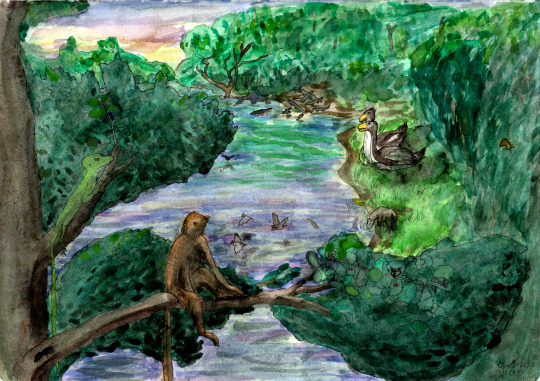
On a lovely evening 47 million years ago, Darwinius and Geiseltaliellus are forced to share their favourite lakeside tree. They do not particularly enjoy each other's company, but are unlikely to do something about it. Their tree has also become the grave of a couple of Titanomyrna infected with a cordycipitoid fungus, the giant ants spreading the fungus in their death grips. Meanwhile, a pair of Gastornis enjoys the evening Sun while a Eurohippus takes a drink, safe in the knowledge that these giant birds are herbivores. Archaeonycteris hunt insects above the lake, while various crocodylians hang out and get ready for the night.
#darwinius#geiseltaliellus#gastornis#eurohippus#titanomyrna#cordyceps#archaeonycteris#eocene#paleogene#paleoart#palaeoblr#my art#kopidodon#messel pit#adapiform#primate#mammal#corytophanid#lizard#squamate#bird#equid#perissodactyl#ant#insect#cw: bugs#cw: parasites#bat#crocodylian#i think that's everyone
59 notes
·
View notes
Text
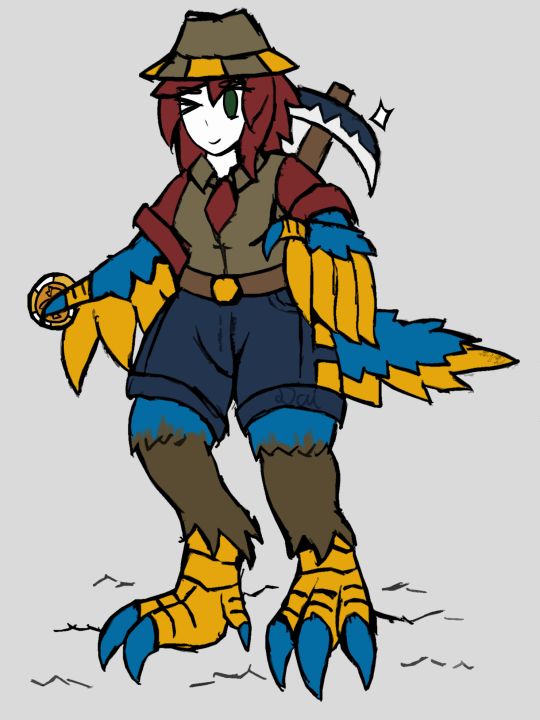
Day 12 - and the last day of doodling dinosaur monsterfolk.
Here's a Gastornis (Tryma) harpy lass who is also a fossil fighter.
And here's a collage piece I made.
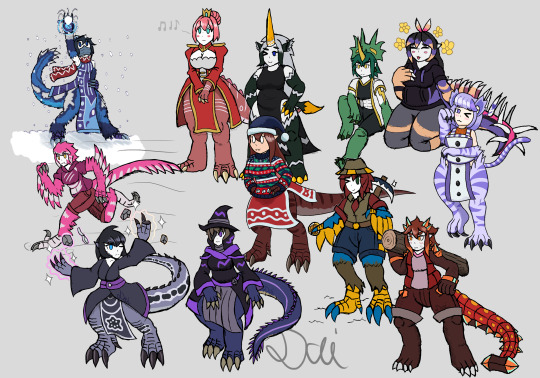
#art#digital art#doodle#monster girl#monsterfolk#monster girls#dinosaur girl#gastornis#diatryma#fossil fighters fanart#gijinka#vivosaur#terror bird
26 notes
·
View notes
Text

PETM (Paleofacture 26), October 2024, oil on canvas, 16x16in.
#artists on tumblr#oil painting#janet bruesselbach#original art#paleofacture#the silurian hypothesis#gastornis#big bird#industrialization#paleontology#speculative realism#fossil fuels
4 notes
·
View notes
Text

First edition cover art for The Serpent by Jane Gaskell. Artist unknown.
Note the resemblance between the Diatryma depicted on the cover and this one illustrated by Zdenek Burian for the book Prehistoric Animals by Professor Joseph Augusta:

Gaskell cites this book as an important reference for the setting of her Atlan series.
2 notes
·
View notes